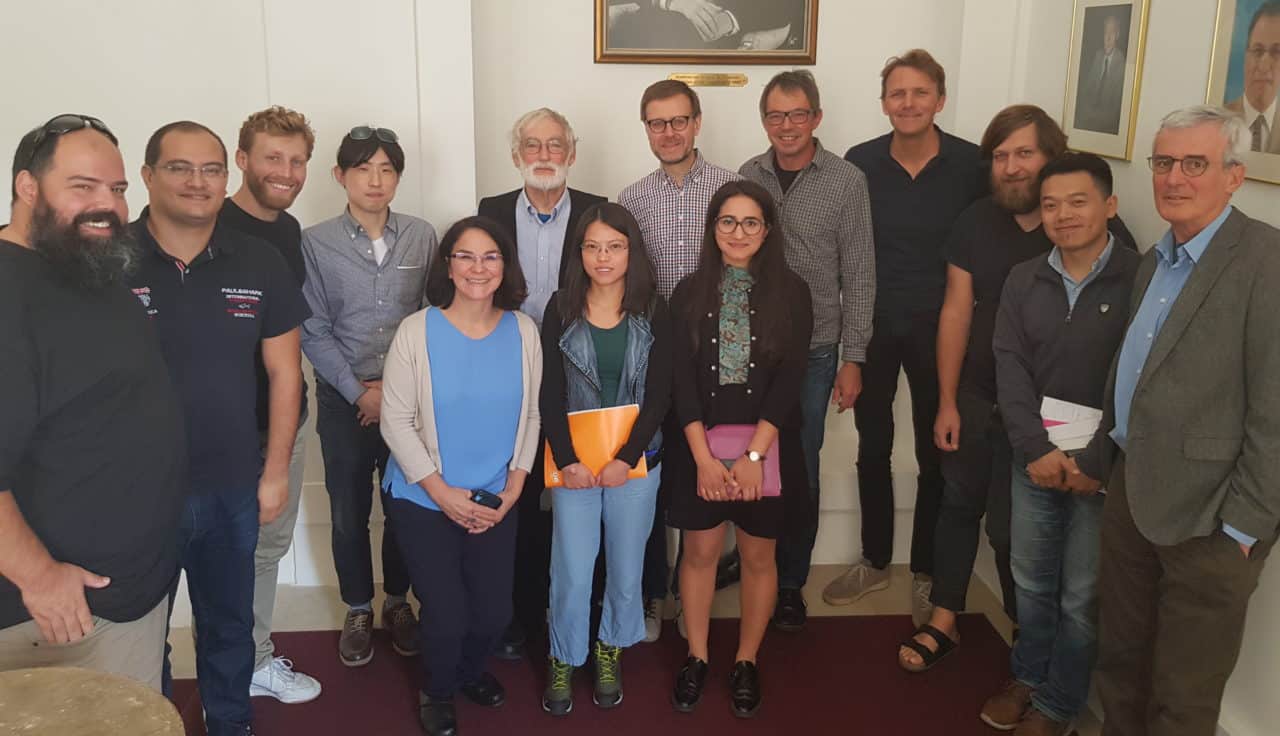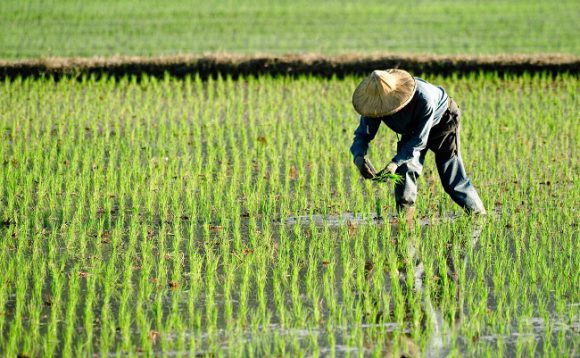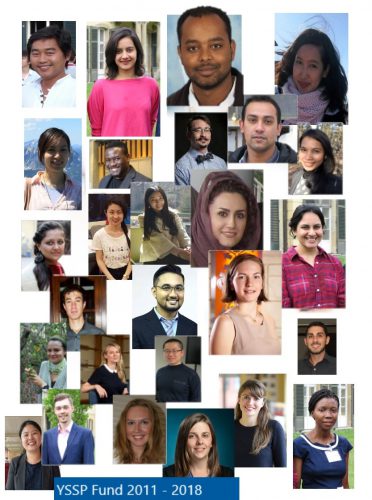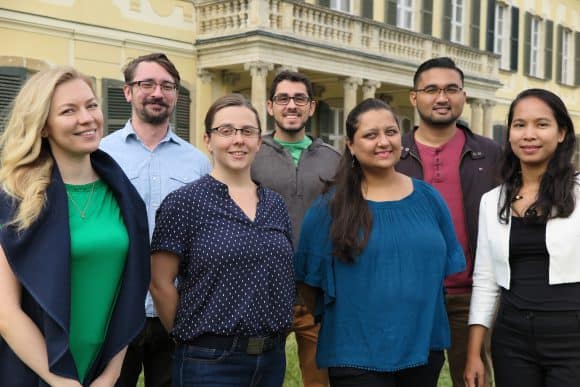Sep 17, 2019 | Alumni, IIASA Network
Monika Bauer, IIASA Network and Alumni Officer, interviewed alumnus Dennis Meadows during his recent visit to IIASA.

Dennis Meadows with colleagues in the IIASA Water & RISK Programs © Monika Bauer | IIASA
“It’s a great pleasure to be back at IIASA because the institute really had a big impact on my professional life,” said Dennis Meadows, coauthor of the seminal book Limits to Growth, after his lecture to IIASA staff during a recent visit to the institute. “I came to IIASA, and it gave me so many new ideas and contacts. It became the fuel for my professional activities for a long time.”
Meadows visited the IIASA Energy Program in 1977 when Roger Levien was director, and he says that Levien greatly impacted the way he viewed problems. In his lecture titled, Lessons from 50 years of model-based policy advocacy, he pointed out that Levien looked at problems as universal or global, and that he uses the criteria Levien passed on to him in what he calls “problem selection” to this day. Meadows also spent some time at the institute from 1983-1984 when C.S. Buzz Holling was director.
During his lecture, Meadows highlighted the idea of using the concept of an “invisible college” as a strategy to implement academic work. He explained that an “invisible college” usually constitutes a group of about 50 people connected with an issue, who, while they do not necessarily all have to agree on the issue or do the same work, can collectively come up with a solution.

© Dennis Meadows
Meadows created his version of an invisible college through the Balaton Group, a global network for collaboration on systems and sustainability that he founded in 1982. He says that the network is meant to “connect and empower people who will go back home and do good things”. Meadows stopped by IIASA on his way to the group’s annual retreat in at Lake Belaton in Hungary, where 50 leading scientists, teachers, consultants, writers, and managers annually get together to discuss topical issues on their own costs. According to Meadows, this in itself shows the value individuals see in the meetings. The results of past meetings are outlined on the group’s webpage.
When asked about his key messages for IIASA, Meadows’ answers focused on the institute’s alumni network and exploring a deeper understanding of resilience.
“The incredible power of IIASA lies in its alumni, rather than in its models. You create the alumni network through the process of creating models. IIASA doesn’t have many models, but it has thousands of alumni. One of the first things I would look at is how to link alumni more strongly together, so they could help each other. I still have affection for the institute and respect for what it does, and I’m sure that my opinion is shared by many.”
His second take-away for IIASA concerns building a deeper expertise on resilience. “Sustainable development is something that is hard to realize, while there is no doubt that shocks will continue to occur, and there is no unified theory in resilience yet. In my opinion, IIASA has an opportunity to tap into a huge legacy of understanding that goes back to Buzz Holling’s work.”
Note: This article gives the views of the author, and not the position of the Nexus blog, nor of the International Institute for Applied Systems Analysis.
Jul 31, 2019 | Alumni, IIASA Network, India, Women in Science
By Nandita Saikia, Assistant Professor of Population Studies at Jawaharlal Nehru University, New Delhi, and former postdoctoral researcher at IIASA
IIASA alumna Nandita Saikia, looks back on the two years that she spent living in Austria while working as a postdoctoral researcher in the World Population Program.
The submission of my PhD thesis, marriage, taking up a university position, and becoming a mother, all happened rather quickly for me. By the time I realized that I wanted to experience working outside of my own country, a good five years had flown by from the day that I received my PhD. For a female academic, who is trying to balance family and work, a decision to move abroad was never going to be easy. It needed a lot of planning, not only in terms of the research topic that I wanted to pursue, but also in terms of organizing things in a way that would lead to the least disruption for the research students I was supervising and of course, my family.

Nandiita Saikia | © Nandita Saikia
With little hope and many conditions, I searched for postdoctoral positions on the websites of various institutes. I was amazed when I found an advertisement for a postdoc position at IIASA, which mentioned that it had extended application deadlines for another 18 months – specifically to accommodate female candidates on maternity leave. This gender sensitive rule made my application possible, and ultimately gave me a rich experience and memories that I will cherish forever.
Looking back at the past two years at IIASA, a long list of reasons why this was such an amazing time of my and my family’s lives, comes to mind. The institute is housed in a beautiful two hundred and seventy five year old castle in Laxenburg just outside of Vienna. As an IIASA employee, my family and I could access the green imperial park once meant for Austria’s iconic empress Sissi, at any time. Apart from massive, century old trees that may have shaded Sissi on her own visits, the park contains a spring, a waterfall, and a lake with numerous monuments to Austrian royal families that frequented it over the centuries. The lush green trees, the musical sound of the spring, together with chirping wild ducks and swans, the Laxenburg castles, the tall yellow church under the deep blue sky – all constantly stimulated the spirit of a nature lover like me.
In terms of the more practical aspects of working at IIASA, staff from administration were always available to address all our personal and professional issues efficiently and warmly. We were supported with everything from extending our visas, finding a suitable place to live, and communicating with my son’s school in German, to locating the right physician. The IIASA Communication Department also helped me to convey the meaning of my research in “non-technical language” to a wider audience, for whom the findings are ultimately meant.
The soul of IIASA is truly international and inter-disciplinary. From North to South, East to West, I met colleagues from all parts of the world. The overall research environment is conducive to doing quality research. Our program director, Wolfgang Lutz, extended all possible support for me to stay at IIASA for two years. I however still had enough freedom to manage my responsibilities in terms of the supervision of my PhD students back in India.
IIASA always encourages its employees to be active and fit and supports them to do this in numerous ways. There are a number of clubs and activities on offer, including yoga, a music club, a running club, a swimming club, cycling, German lessons, aerobics, and a tennis club. The institute also maintains a gym for staff members. Some of my colleagues even kept workout clothes in the office for when they could manage to participate in some of these activities amidst their busy schedules. Although it was of course not possible to be in all the clubs, you had a choice, which contributed to the overall “feel good” environment. Being an international research organization, IIASA celebrates the different cultures of its staff members by organizing themed social gatherings like Asia Day, Latin American Day, Canada Day, and Mediterranean Day, to name a few, during which staff have the chance to taste authentic homemade cuisines and see cultural music or dance performances by colleagues. My heart knew no bounds when I got a chance to perform a Bollywood number and an Indian folk dance with my international colleagues!
I also developed an affinity with the IIASA Women in Science Club, which often organized “Meet, Greet and Eat” sessions during which we had the opportunity to interact with established women scientists in an informal way. It was indeed an eye opener to learn about how they overcame common challenges either in their early or later careers.
During our stay, we fully experienced life in Vienna, which has repeatedly been ranked as the best city in the world to live in. The centrality of Vienna also helped us to explore many neighboring countries. In our second year, we lived in Laxenburg where we felt very much at home. We loved how smoothly the little town runs while offering everything needed for a high quality life when raising young children.
Our time at IIASA was extremely productive, but we still felt as if we were in Vienna for a two-year long vacation! If someone asks me whether they should consider IIASA for a post doc or the Young Scientists Summer Program, my answer will be: “Yes, don’t even think twice!”
Nandita Saikia was a postdoctoral researcher at IIASA from 2017 to 2019. More information available at www.nanditasaikia.com.
Note: This article gives the views of the author, and not the position of the Nexus blog, nor of the International Institute for Applied Systems Analysis.
May 17, 2019 | Alumni, Risk and resilience, Young Scientists
By Tobias Sieg, IIASA Young Scientists Summer Program alumnus
IIASA Young Scientists Summer Program alumnus Tobias Sieg explains how risk assessments considering uncertainties can substantially contribute to better risk management and consequently to the prevention of economic impacts.

© Topdeq | Dreamstime.com
According to the World Economic Forum’s Global Risk Landscape 2018, extreme weather events and natural disasters are ranked among the top three global risks. For many regions, hydro-meteorological risks – in other words, weather or water related events like cyclones or floods that pose a threat to populations or the environment – constitute the biggest threat. This calls for a comprehensive scientific risk assessment with a particular focus on large associated uncertainties.
Assessing the risk of hydro-meteorological hazards without considering these uncertainties, is like entering a pitch-dark labyrinth. You have no idea where you are and where you will end up. If you enter with a flashlight, you might still not immediately know exactly where you will end up, but at least you can assess your possibilities for finding a way out.
We should all care to see those possibilities and to identify uncertainties, since the consequences of hydro-meteorological hazards can have severe impacts on socioeconomic systems, and global- and climate change could favor the occurrence of floods. An increase in extreme weather events, such as heavy precipitation can be expected along with an increasingly warmer climate. In combination with uncontrolled socioeconomic development, these extreme weather events could potentially trigger more intense hazardous flood events in the future. Appropriate management of their consequences is therefore required, starting from today, while pro-actively thinking about the future. To that end, risk management policy and practice need reliable estimates of direct and indirect economic impacts.
The reliability of existing estimates is usually quite low and, what is maybe even worse, they are not communicated properly. This may signal a false sense of certainty regarding the prediction of future climate-related risks.
In two recent studies, my co-authors and I developed and applied a novel method, which specifically focuses on the communication of the reliability of economic impact estimates and the associated uncertainties. The proposed representation of uncertainties enables us to shed some light on the possibilities of how a specific event can affect economic systems. As a Young Scientists Summer Program (YSSP) participant with the IIASA Risk and Resilience Program, I applied the method together with my supervisors Thomas Schinko and Reinhard Mechler, to estimate the overall economic impacts of a major flood event in Germany in 2013.
The estimated overall economic impacts comprise both direct and indirect impacts. Direct impacts are usually caused by physical contact of the floodwater with buildings, while indirect impacts can also occur in regions that are not directly affected by a flood. For example, obstructions of the infrastructure can lead to delayed deliveries, in turn leading to negative impacts for the production of goods outside the flooded areas. The crucial novelty of this method is the integrated assessment of direct and indirect economic impacts. In particular, by considering how the uncertainties associated with the estimation of direct economic impacts propagate further into the estimates of indirect economic impacts.
Being able to reproduce what has happened in the past is essential to making credible predictions about what could potentially happen in the future. A comparison of reported direct economic impacts and model-based estimates reveals that the estimation technique already works quite reliably. The good news is that anyone can help to increase the predictive reliability even further. The method uses the crowdsourced OpenStreetMap dataset to identify affected buildings. The more detailed the given information about a building is, the more reliable the impact estimations can get.
Our study reveals that the potential of short-term indirect economic impacts (without considering recovery) are quite high. In fact, our results show that the indirect impacts can be as high as the direct economic impacts. Yet, this varies a lot for different economic sectors. The manufacturing sector, for instance, is much more affected by indirect economic impacts, since it is heavily dependent on well-functioning supply chains. This information can be used in emergency risk management where decisions have to be made about giving immediate help to companies of a specific sector to reduce high long-term indirect economic impacts.
We are now looking at different possibilities of how flood events could affect the economic system. Having a range of possibilities of the relation between these impacts makes them transferable between different regions with similar economic systems. Our results are therefore also relevant more broadly beyond the German case. This representation of uncertainties can help to get to a more credible and consistent risk assessment across all spatial scales. Thus, the method is able to potentially facilitate the fulfillment of some of the calls of the UN Sendai Framework for Disaster Risk Reduction.
Detailed risk assessments considering uncertainties can substantially contribute to better risk management and consequently to the prevention of economic impacts – direct and indirect, both now and in the future.
References:
[1] Sieg T, Schinko T, Vogel K, Mechler R, Merz B & Kreibich H (2019). Integrated assessment of short-term direct and indirect economic flood impacts including uncertainty quantification. PLoS ONE 14(4): e0212932. [pure.iiasa.ac.at/15833]
[2] Sieg T, Vogel K, Merz B & Kreibich H (2019). Seamless estimation of hydro-meteorological risk across spatial scales. Earth’s Future. https://doi.org/10.1029/2018EF001122
Note: This article gives the views of the author, and not the position of the Nexus blog, nor of the International Institute for Applied Systems Analysis.
Apr 12, 2019 | Alumni, China, Climate, Women in Science, Young Scientists
By Kejia Hu, PhD Candidate at Zhejiang University, China and IIASA Young Scientists Summer Program (YSSP) 2016 participant
Kejia Hu, an alumna of the IIASA Young Scientists Summer Program, discusses a recent study on how extreme temperatures affect the health risks experienced by urban and rural communities in China.
Hot and cold temperatures are associated with increased risks of cause-specific mortality, in other words, deaths that result from, for instance, cardiovascular and respiratory conditions. Due to the urban heat island effect – where an urban heat island is a city or metropolitan area that is significantly warmer than its surrounding rural areas due to human activity – it is commonly assumed that urban residents are at a higher risk of exposure to extreme heat than their rural neighbors are. Very few studies have explored the urban-rural differences of temperature-related health risks, often because of the lack of sufficient meteorological and health data in rural areas.
Today, 45% of the global population – nearly 3.4 billion people – still live in rural regions, and based on the UN’s World Urbanization Prospects 2018, there will still be more than 3 billion people living in these areas by 2050, despite current trends such as urbanization.
This made us wonder whether there could be a rural-urban gap in extreme temperature induced health risk. We decided to conduct a study to address this question in Zhejiang province in eastern China employing high spatial resolution data on temperature, death registrations, air pollution, and population density across 89 counties in Zhejiang from 2009 to 2015.
Based on an epidemiological analysis of more than 2 million death cases, we found that rural residents are more sensitive to both cold and hot temperatures than urban residents, and that extreme temperatures especially affect the elderly. Our results indicate that extreme cold temperatures increased the mortality rate by 98% for rural populations, and by 47% for urban populations, while extremely hot temperatures increased the mortality rate by 18% for rural populations and by 14% for urban populations. When considering both human exposure and vulnerability, the attributable deaths from cold and hot temperatures were 4.8 and 2.6 times higher in rural than in urban areas, respectively.

© Elwynn | Dreamstime.com
But why do rural populations tend to have higher mortality risks in the face of both cold and heat? Our results suggest that age, education, income, access to health care services and air conditioners, and the types of occupations that residents in these areas engage in, are among the potential sources. We found that counties with higher percentages of elderly and agricultural employment, lower levels of education, lower income levels, fewer hospital beds, and fewer air conditioners, had higher mortality risks related to both heat and cold. This could mean that socioeconomic vulnerability may play an important role – even more important than temperature in the determinants of temperature-related health risks.
Ours is the first study to find an urban–rural disparity in both heat and cold mortality risks. Importantly, it challenges the general assumption in previous studies in developed countries that urban residents are at a higher risk to extreme high temperatures. Our findings suggest that previous studies, which mostly investigated exposure-response associations using data from urban areas, may have underestimated the mortality burden for the entire population.
Although the Chinese government have standards in place regarding thermal comfort in residential buildings and highly recommend that they are implemented for rural houses, unfortunately, until now, this has only been enforced for urban apartments in China. In addition, due to lower income, rural households are more likely to fall into “fuel poverty” compared to urban households, which will limit the use of air conditioners for rural people. Targeted measures such as financial assistance for paying electricity bills will help build rural residents’ resilience to extreme temperatures.
Our findings have important implications for policy, particularly in developing countries. Overall, no single action will be enough to reduce the temperature-related mortality risks in rural areas. More efforts should be made to narrow the urban-rural gaps that persist in access to health care by, for example, increasing investment in health care facilities and health care professionals in rural areas. Improving rural people’s general awareness of temperature related risks, such as to popularize preventive knowledge and to develop early warning systems is also needed to prevent temperature-related deaths.
Reference:
Hu K, Guo Y, Hochrainer-Stigler S, Liu W, See L, Yang X, Zhong J, Fei F, et al. (2019). Evidence for Urban–Rural Disparity in Temperature–Mortality Relationships in Zhejiang Province, China. Environmental Health Perspectives 127 (3): e037001. [pure.iiasa.ac.at/15773]
Note: This article gives the views of the author, and not the position of the Nexus blog, nor of the International Institute for Applied Systems Analysis.
Jan 21, 2019 | Alumni, IIASA Network, Young Scientists
By Marzena Anna Adamczuk, Development Officer, Office of Sponsored Research, IIASA

YSSP Fund recipients from 2011 to 2018
The 27 fellows smiling at you from the photograph are all part of the IIASA global network of system thinkers thanks to the Young Scientists Summer Program (YSSP) Fund. The YSSP Fund accepts donations from the IIASA community and directs the proceeds to support young scholars who are not eligible to receive a stipend from an IIASA National Member Organization.
The IIASA experience has had a profound influence on the lives of previous recipients, and has brought them closer to answering some of their most pertinent research questions. J. Luke Irwin (2018 YSSP Fund), for example, was able to explore which jobs and skills are the least automation resilient and how policymakers and academic institutions should address future unemployment caused by automation. Another previous beneficiary of the fund, Diana Erazo (2016 YSSP Fund), looked at the transmission dynamics of Chagas disease – one of the most neglected tropical diseases in Latin America – and the most efficient strategies to contain it.
Since its inception in 2011, the YSSP Fund has opened the IIASA door to 27 young researchers from Ethiopia, Thailand, India, China, Colombia, Brazil, and many other countries. All these scholars have since become an important part of the IIASA worldwide network, enriching the institute’s research portfolio and planting the seeds of their newly acquired systems analysis expertise in their home countries.
This bridge-building and door-opening capacity of the YSSP Fund is what inspires many members of the IIASA family to support it every year. Ever since I was appointed as development officer at IIASA in 2014, I have been privileged to accept donations from former IIASA directors, eminent researchers, and renowned experts in a variety of fields. We are all united in our belief that supporting the YSSP Fund is a great investment in future generations of researchers and an important token of trust in IIASA and its flagship capacity-building program.
Many of our alumni donors are former YSSP fellows, who appreciate the impact the program has had on their careers. One of them is Petr Aven, who was part of the first YSSP cohort in 1977 and still remembers this experience as the best time of his life. Some of our alumni, who were themselves recipients of the YSSP Fund scholarship, see it as their duty and privilege to give back. One of our most distinguished donors, Dr. Roger Levien, former director of IIASA and the founder of the YSSP, hopes that his donations will help build a bridge between IIASA and Pardee RAND Graduate School, of which he is an alumnus as well. The motivation behind our most recent pledge from Professors Jyoti and Kirit Parikh is to expose young minds to systems analysis and to promote research-based policymaking.
After the annual fundraising campaign is over and the IIASA network lives up to the challenge for yet another year, I find it very gratifying to be able to channel the support coming from the IIASA community to the YSSP Fund recipients. My favorite time of the year is June when I get to meet the lucky recipients of the scholarships, learn all about their plans and ambitions for the summer at IIASA, and see how motivated they are to make the most of their time at the institute.
However, the real satisfaction kicks in when I see the YSSP Fund fellows thrive in their post-IIASA careers. With immense support from our alumni officer and the Communication Department, we take great pride in sharing their successes with the IIASA worldwide community. We see it as a token of gratitude to both the donors, who opened the IIASA door to them, as well as to their IIASA supervisors, who generously shared their expertise and continue to mentor them after their summer at the institute is over.
Speaking of successes, Gbemi Samuel (2017 YSSP Fund), the first Nigerian to ever participate in the program has recently published a well-received article in the Journal of African Population Studies describing her research on estimating how many children under five could be prevented from dying if women in Nigeria used cleaner fuels to cook their family meals. Lu Liu, a 2016 YSSP Fund recipient published her first-authored paper in Environmental Research Letters and had a poster presentation at the AGU Fall Meeting in Washington D.C. We are also very proud of Zhimin Mao’s (2015 YSSP Fund) post-IIASA career, starting from her IIASA Peccei Award in 2015 and leading up to her current position at the World Bank. We can hardly wait to boast about the successes and accomplishments of our 2018 YSSP Fund fellows and hope they will stay in touch.
Every donation to the YSSP Fund goes a long way. Help us close more funding gaps this summer and support the next generation of system thinkers!

2018 YSSP Fund recipients: (L-R) Ekaterina Antsygina, Luke Irwin, Sara Turner, Fabio Diuana, Ankita Srivastava, Muhammad Nurariffudin, Fumi Harahap
Support the 2019 YSSP Fund
Note: This article gives the views of the author, and not the position of the Nexus blog, nor of the International Institute for Applied Systems Analysis.
Jan 11, 2019 | Alumni, Energy & Climate, IIASA Network, Water, Women in Science, Young Scientists
By Lu Liu, postdoctoral research associate at Rice University, USA and IIASA YSSP 2016 participant
I have been attending the American Geophysical Union (AGU) Fall Meeting since 2013 when I was working with the Joint Global Change Research Institute. Ever since then, the AGU Fall Meeting has become one of my most anticipated events of the year where I get to share my research and make new friends.
The first time I attended the AGU Fall Meeting, I was overwhelmed with the size and scale of this conference. There are more than 20,000 oral and poster presentations throughout the week, and the topics cover nearly 30 different themes, from earth and space science, to education and public affairs. I was thrilled to see my research being valued and discussed by people from various backgrounds, and I was fascinated by other exciting research and rigorous ideas that emerged at the meeting.

Lu Liu at 2018 AGU poster session
At this year’s AGU, I presented my poster Implications of decentralizing urban water supply infrastructure via direct potable water reuse (DPR) in a session titled Water, Energy, and Society in Urban Systems. In a nutshell, my poster presents a quantitative model that evaluates the cost-benefits of direct potable water reuse in a decentralized water supply system. The concept of decentralization in an urban water system has been discussed in previous literature as an effective approach towards sustainable urban water management. Besides the social and technical barriers in implementing decentralization, there is a lack of analytical and computational tools necessary for the design, characterization, and evaluation of decentralized water supply infrastructure. My study bridges the gap by demonstrating the environmental and economic implications of decentralizing urban water infrastructure via DPR using a modeling framework developed in this study. The quantitative analysis suggests that with the appropriate configuration, decentralized DPR could potentially alleviate stress on freshwater and enhance urban water sustainability and resilience at a competitive cost. More about this research and my other work can be found here: https://emmaliulu.wixsite.com/luliu.
At the AGU Fall Meeting, I engaged in various opportunities to reconnect with old colleagues and build new professional relationships. What’s better than running into my former YSSP supervisors and IIASA colleagues after two years since I left the YSSP? Although my time spent at IIASA was short, I hold IIASA and the YSSP very close to my heart because the influence this experience has had on my professional and personal life is profound.
I will continue to attend the AGU Fall Meeting for the foreseeable future. After all, we all want to feel a sense of belonging and acceptance in a community, and I am glad I already found mine.
Note: This article gives the views of the author, and not the position of the Nexus blog, nor of the International Institute for Applied Systems Analysis.









You must be logged in to post a comment.